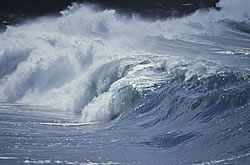The effect of oceanic turbulence on plankton
Turbulence can be defined as irregular, random motion of a fluid. It plays an important role in the world's oceans, mixing heat, momentum, chemical species and nutrients on many different spatial and temporal scales. The EESD Programme funded the NTAP project to take a closer look at oceanic turbulence and plankton. Plankton, constitutes the initial link in the ocean's complex food chain.The question put to NTAP partner Observatoire Oceanologique of Universite Pierre et Marie Curie was whether turbulence promotes or inhibits the production of plankton. The Observatoire Oceanologique constructed a turbulence generator and subjected a subset of plankton called ciliates to various levels of turbulence. The scientists discovered that while cell division is not affected, ingestion rates are increasingly hampered as turbulence increases. They postulate that the turbulent waters disturb the ciliates' ability to swim effectively. Additional experiments with the ciliate Strombidium sulcatum revealed that turbulence further limited reproduction by increasing respiration rates. On the other hand, when experiments were performed with multiple species, no effects of turbulence were detected. Nor did water column experiments indicate turbulence-related reductions in species diversity. So what does the Observatoire Oceanologique make of these mixed results? First, it emphasises the strong dependency of turbulence effects on species. Some species are clearly affected more than others. The recommendation is that turbulence can be ignored in models addressing multiple species. Conversely, in situations where species are limited in number, such as wastewater treatment facilities, the effects of turbulence on growth must be accounted for. The Observatoire Oceanologique is seeking collaboration for further experimentation with its turbulence generator and use of its existing experimental dataset.







